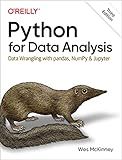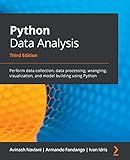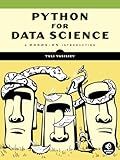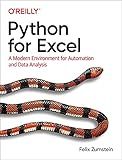Best Python Data Analysis Tools to Buy in December 2025

Python for Data Analysis: Data Wrangling with pandas, NumPy, and Jupyter



Python Crash Course, 3rd Edition: A Hands-On, Project-Based Introduction to Programming



Python for Data Analysis: Data Wrangling with Pandas, NumPy, and IPython



Python Data Analysis: Perform data collection, data processing, wrangling, visualization, and model building using Python, 3rd Edition



Python for Data Science: A Hands-On Introduction



Python for Excel: A Modern Environment for Automation and Data Analysis


To apply an expression to a Pandas dataframe, you can use various methods provided by the library. Here are some ways to do so:
- Using DataFrame.apply(): The apply() function allows applying a function along either axis of the dataframe. You can pass a lambda function or a custom-defined function to perform the desired operation on each element, column, or row.
- Using DataFrame.applymap(): If you want to apply an expression element-wise on a dataframe, you can use the applymap() method. It applies a Python function to every element of the dataframe.
- Using DataFrame.eval(): The eval() method allows evaluating an expression on a dataframe efficiently. It can handle arithmetic operations and apply them column-wise using the evaluated expression.
- Using DataFrame.assign(): If you want to add new columns to a dataframe by applying an expression, you can use the assign() method. It allows assigning new columns based on existing ones, created using pandas expressions.
These methods provide flexibility and efficiency in applying expressions on a dataframe. Choose the appropriate method based on your specific requirements and the type of operation you want to perform.
How to apply datetime expressions or manipulations to a Pandas dataframe?
To apply datetime expressions or manipulations to a Pandas dataframe column, you can use the pd.to_datetime() function to convert the column to a datetime type. Once the column is converted, you can access the datetime properties and apply various operations.
Here's an example of how to apply datetime expressions to a Pandas dataframe:
import pandas as pd
Create a sample dataframe
data = {'date': ['2022-01-01', '2022-01-02', '2022-01-03'], 'value': [10, 15, 20]} df = pd.DataFrame(data)
Convert the 'date' column to datetime type
df['date'] = pd.to_datetime(df['date'])
Access datetime properties and apply operations
df['year'] = df['date'].dt.year df['month'] = df['date'].dt.month df['day'] = df['date'].dt.day df['weekday'] = df['date'].dt.weekday_name
Apply datetime operations
df['previous_day'] = df['date'] - pd.DateOffset(days=1) df['next_month'] = df['date'] + pd.offsets.MonthEnd()
print(df)
Output:
date value year month day weekday previous\_day next\_month
0 2022-01-01 10 2022 1 1 Saturday 2021-12-31 2022-01-31 1 2022-01-02 15 2022 1 2 Sunday 2022-01-01 2022-01-31 2 2022-01-03 20 2022 1 3 Monday 2022-01-02 2022-01-31
In this example, the 'date' column is first converted to datetime using pd.to_datetime(). Then, various datetime properties such as 'year', 'month', 'day', and 'weekday' are accessed using the .dt accessor. Additionally, datetime operations like adding or subtracting days can be performed using Pandas offsets, such as pd.DateOffset() or pd.offsets.MonthEnd().
How to handle missing values while applying expressions to a Pandas dataframe?
When applying expressions to a Pandas DataFrame, missing values (NaN or None) can cause issues and may need to be handled. Here are several ways to handle missing values while applying expressions:
- Dropping the missing values: Use the dropna() method to remove rows or columns with missing values before applying the expression. For example:
df.dropna() df.dropna(axis=1) # drop columns with missing values
- Filling missing values: Use the fillna() method to replace missing values with a specified value or strategy (mean, median, etc.). For example:
df.fillna(value=0) # fill missing values with 0 df.fillna(df.mean()) # fill missing values with column means
- Ignoring missing values: Some operations automatically ignore missing values. For instance, mathematical operations performed using built-in functions, like sum(), mean(), min(), etc., ignore missing values by default.
- Using conditional expressions: You can apply conditional expressions to handle missing values. For example:
df['new_column'] = df['column'].apply(lambda x: x if pd.notna(x) else some_value)
- Using the np.where() function: This NumPy function allows you to replace values based on a condition. For example:
import numpy as np df['column'] = np.where(pd.isna(df['column']), new_value, df['column'])
- Interpolating missing values: If the missing values have a time series or sequential pattern, you can interpolate them using the interpolate() method. For example:
df.interpolate()
Remember to assess the suitability of each method based on the specific characteristics and requirements of your data.
How to calculate descriptive statistics using expressions in a Pandas dataframe?
To calculate descriptive statistics using expressions in Pandas DataFrame, you can make use of the apply() method along with lambda functions. Here's an example:
Let's say you have a DataFrame df with columns "A" and "B", and you want to calculate the mean, median, and standard deviation of their difference, which is (A - B).
import pandas as pd
Create a DataFrame
data = {'A': [1, 2, 3, 4, 5], 'B': [2, 4, 6, 8, 10]} df = pd.DataFrame(data)
Calculate descriptive statistics using expressions
mean_diff = df.apply(lambda row: row['A'] - row['B'], axis=1).mean() median_diff = df.apply(lambda row: row['A'] - row['B'], axis=1).median() std_diff = df.apply(lambda row: row['A'] - row['B'], axis=1).std()
Print the calculated statistics
print("Mean difference:", mean_diff) print("Median difference:", median_diff) print("Standard deviation of difference:", std_diff)
This code uses the apply() method along with a lambda function to calculate the element-wise difference between column "A" and column "B". The axis=1 parameter ensures that the lambda function is applied row-wise. Then, you can use the mean(), median(), and std() methods to calculate the desired descriptive statistics on the resulting Series.
What is the role of the applymap() method in applying expressions to a Pandas dataframe?
The applymap() method in pandas is used to apply a function or expression element-wise to each element of a DataFrame. It is specifically designed to work on individual cells of a DataFrame rather than on entire rows or columns.
The primary role of the applymap() method is to transform the values of a DataFrame by applying a given function or expression to each element. It creates a new DataFrame by applying the function or expression to each element individually, without modifying the dimensions of the original DataFrame.
Here's an example to illustrate the usage of applymap():
import pandas as pd
Sample DataFrame
df = pd.DataFrame({'A': [1, 2, 3], 'B': [4, 5, 6]})
Applying a square function element-wise using applymap()
df_square = df.applymap(lambda x: x**2)
print(df_square)
Output:
A B 0 1 16 1 4 25 2 9 36
In this example, the applymap() method is used to apply a lambda function that squares each element of the DataFrame df. The resulting DataFrame df_square contains the squared values.
The applymap() method is particularly useful when you need to apply a custom operation or expression to each individual cell of a DataFrame. However, it can be less efficient compared to other methods like apply() or vectorized operations for applying functions element-wise, especially for large data sets.
What are some common mistakes made when applying expressions to a Pandas dataframe?
Some common mistakes made when applying expressions to a Pandas dataframe include:
- Not specifying the correct syntax for accessing a column. For example, using dot notation (df.column_name) instead of square brackets (df['column_name']), which is necessary when the column name has spaces or special characters.
- Forgetting to assign the result of the expression back to a column or a new variable. Pandas doesn't modify the dataframe in-place by default. Therefore, without assigning the result of an operation, the original dataframe remains unchanged.
- Mismatch in the dimensions of the operands. Certain operations like addition or multiplication between dataframes or series require them to have the same shape. In such cases, ensure that the columns or series being operated on have compatible dimensions.
- Ignoring missing or NaN values. Some mathematical operations on dataframes or series may produce NaN values when missing data is encountered. It's important to handle or account for this missing data appropriately to avoid unexpected results or errors.
- Applying operations to non-numeric columns. Some operations may only be applicable to numeric data types. Trying to perform arithmetic or mathematical operations on non-numeric columns can result in errors.
- Incorrectly using boolean operators. When using boolean operators (and, or, not), it's essential to use the bitwise versions (&, |, ~) to apply them element-wise to a dataframe or series. Using the logical operators incorrectly can result in unexpected behavior.
- Overwriting the original dataframe inadvertently. When performing operations that create a new dataframe with modified or computed values, it's crucial to store the result in a new variable or a different column name. Overwriting the original dataframe can lead to the loss of data.
- Neglecting to handle datetime and string conversions. Pandas provides functionality to convert columns to datetime or string data types, which can enable operations specific to these types. Not converting the columns correctly can lead to errors when applying expressions or operations.
Remember to carefully check the syntax, data types, dimensions, missing values, and assignments when applying expressions to a Pandas dataframe to avoid these common mistakes.
How to apply an expression to a Pandas dataframe?
To apply an expression to a Pandas DataFrame, you can use various methods such as apply(), applymap(), or map() depending on your requirements. Here's how you can use these methods:
- Using apply() method: If you want to apply an expression to each column or row of the DataFrame, you can use the apply() method. Pass the expression as a lambda function to the apply() method and specify the desired axis (axis=0 for columns, axis=1 for rows). Example applying a function to each column: import pandas as pd df = pd.DataFrame({'A': [1, 2, 3], 'B': [4, 5, 6]}) df = df.apply(lambda col: col * 2) # Apply expression to each column Example applying a function to each row: import pandas as pd df = pd.DataFrame({'A': [1, 2, 3], 'B': [4, 5, 6]}) df = df.apply(lambda row: row['A'] + row['B'], axis=1) # Apply expression to each row
- Using applymap() method: If you want to apply an expression element-wise to all the cells in a DataFrame, you can use the applymap() method. Pass the expression as a lambda function to the applymap() method. Example: import pandas as pd df = pd.DataFrame({'A': [1, 2, 3], 'B': [4, 5, 6]}) df = df.applymap(lambda x: x ** 2) # Apply expression element-wise to all cells
- Using map() method: If you want to apply an expression to a specific column or series of the DataFrame, you can use the map() method. Pass the expression as a lambda function to the map() method. Example: import pandas as pd df = pd.DataFrame({'A': [1, 2, 3], 'B': ['Apple', 'Banana', 'Carrot']}) # Define a dictionary mapping for mapping 'A' column values mapping = {1: 'One', 2: 'Two', 3: 'Three'} df['A'] = df['A'].map(lambda x: mapping.get(x, x)) # Apply expression to a specific column
These methods allow you to apply expressions to manipulate the data within a Pandas DataFrame efficiently.
